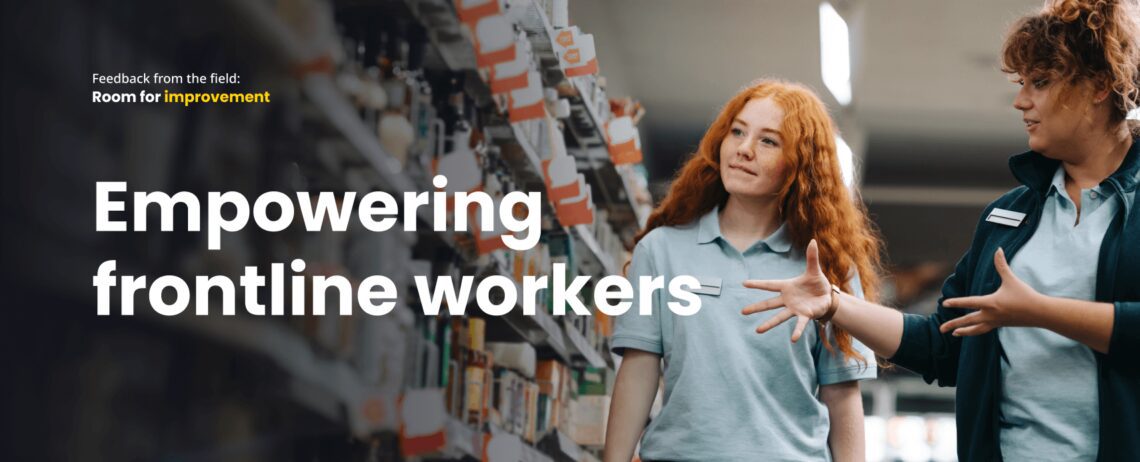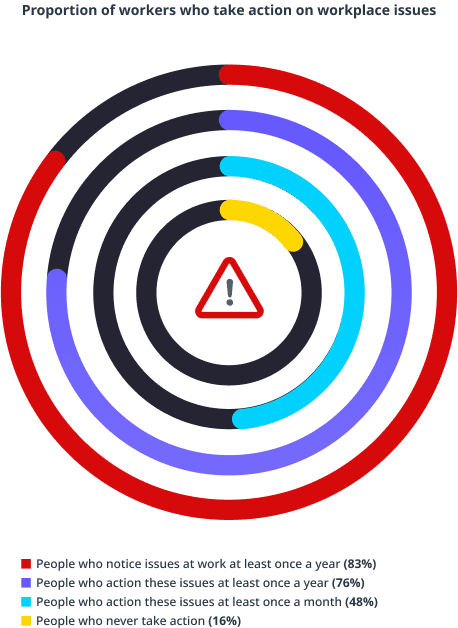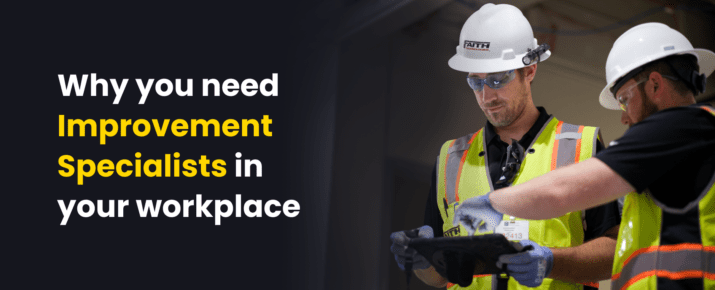Speaking up and taking action: How to empower frontline workers
Feedback From The Field | World Of Work | By | 1 Nov 2023 | 5 minute read

Even the most successful business can’t afford to sit still. They need to continuously improve and evolve in order to remain competitive.
But when it comes to identifying and making those types of strategic advancements towards a better way of working, where do the best ideas come from? As it turns out, leaders aren’t the default source of all of that wisdom — your frontline workers are.
“Improvement is key to future success. The competition will catch you, and the competition will pass you unless you keep on improving,” says M-Sport Team Principal, Richard Millener. The World Rally team uses the SafetyCulture platform to ensure its cars are in peak condition for every race (Read M-Sport’s customer story here).
Your frontline has the foresight
In our recent report, Feedback from the Field: Room for Improvement, 49% of workers believe the best ideas for improving the workplace come from the frontline. Compare that with only 23% of workers who say the best ideas come from management.
And workers aren’t necessarily shy about sharing their suggestions either. The survey, which was conducted in partnership with YouGov, found that 83% of workers have flagged operational issues in the workplace at least once a year, with an impressive 65% saying it happens at least once a month.
It all sounds like good news, right? But here’s where things start to fall apart: action.
Despite the fact that frontline workers speak up, that doesn’t always mean something gets done. Only 76% of workers say they actually see people doing anything to improve upon the issues flagged. An alarming 16% of respondents say they’ve never seen people take action.

4 strategies to empower frontline workers to take action
So where’s the breakdown here? And, even more importantly, how can you fix it? Here are four strategies to empower your frontline workers — and ultimately create a better way of working.
1. Build a culture of innovation
Your workers might feel like they have the autonomy to vocalize their ideas, but that doesn’t mean they feel like they have permission to act on them.
Research shows that, particularly on the frontline — where there are often rigid processes and strict regulations to comply with — it’s easy to stick with a “we’ve always done it this way” attitude. And that philosophy, even if unspoken, will serve as a signal that workers don’t have the freedom or support to make necessary changes.
That speaks to the importance of fostering a culture of innovation as leaders, where frontline workers feel empowered to take ownership of their work and make adjustments when necessary. To do this well, consider:
- Communicating clearly about regulations or other compliance issues so workers understand what can or can’t be altered.
- Giving workers the opportunity to own and spearhead any initiatives they put forward themselves, while offering your support and guidance.
- Involving frontline workers in decision-making, rather than handing down directives.

2. Foster psychological safety
You can’t have a culture of innovation without also prioritizing psychological safety. What is it? As McKinsey explains, “Psychological safety nurtures an environment where people feel encouraged to share creative ideas without fear of personal judgment or stepping on toes.”
It’s an area where frontline workers in particular struggle. According to research, 25% of onsite workers feel their mistakes are held against them, while only 14% of remote or hybrid workers say the same.
You can’t expect frontline workers to stick their necks out and make changes if they feel it might lead to reprimands and repercussions. They need to feel safe and supported in making those improvements — even if it doesn’t pan out the way they hoped.
To cultivate psychological safety, leaders and managers should:
- Model humility by candidly sharing their own challenges or blunders (and not just their successes) with their teams.
- Treat mistakes and missteps as valuable learning opportunities, rather than losses.
- Respond positively and inquisitively to questions, concerns, doubts, or suggestions.
3. Provide adequate leadership training
A culture of innovation and psychological safety is crucial for empowering your frontline workers – but unfortunately, those are areas where a lot of leaders fall short.
In our survey, 30% of workers say their leaders don’t encourage operational improvements. According to research from McKinsey, only a handful of leaders demonstrate the behaviors necessary to instill psychological safety. And data from Microsoft shows that 62% of workers believe the company could do more to prioritize culture and communication from management.
So if you want to empower your frontline workers, you can’t neglect the importance of empowering their managers first. That hinges on the right training — not just training focused on processes and the nitty-gritty work, but also:
- How to effectively respond to feedback and suggestions from the team
- How to model humility and vulnerability
- How to involve workers in the decision-making process
- How to provide guidance and support without micromanaging
This type of training can make a big difference. According to research from Harvard, high-performing organizations are 48% more likely to offer new leaders coaching and increased responsibility than their low-performing counterparts. And leaders are hungry to expand their own knowledge too, with 70% of frontline leaders expressing an interest in developing their leadership skills.
When frontline workers have a suggestion to share, they’ll likely expect their direct manager to serve as their advocate — to be the one to run it up the flagpole and champion their idea. Your leaders might need a little more training and support to successfully fill that role.
Did you know? You can improve the way your team learns with SafetyCulture Training.
4. Implement the right technology
When your frontline workers fail to take action on their ideas for operational improvements, it could simply come back to logistics. Do they know what to do and where to go when they have an idea? Do they have a clearly defined outlet to provide their input? Or are they left with a bunch of uncertainty and aimless wandering?
This is where technology comes into play. Particularly when your frontline workers are dispersed across different facilities, they need one intuitive and reliable place to flag operational issues and provide their feedback. But unfortunately, 60% of frontline workers admit they’re unsatisfied with the technology provided by their employers.
The SafetyCulture platform makes it easy for your frontline workers to call attention to problems as they arrive, right in their daily workflows. The platform also offers relevant training — all from one simple and centralized place.
In short, if you make it difficult for employees to voice their opinions and follow through on them, they’re less likely to do so. Technology is the answer to give workers the encouragement to speak up and take action, as well as the place to actually make it happen.
Lead by example, the rest will follow
Your frontline employees are the ones doing the work day in and day out, so it makes sense that they have the most accurate understanding and astute insights about how your organization can improve.
The last thing you want is to lose out on all of that knowledge and hard-won wisdom. Your frontline workers need to feel empowered to not only speak up with their suggestions but take action and implement them.
Making that happen requires some shifts to your culture, leadership, and even technology. But it’s well worth it. After all, you can’t expect your employees to initiate changes without you doing so first.
About the research
All figures, unless otherwise stated, are from YouGov Plc. Total sample size was 2,057 adults (769 UK, 757 US, 531 Australia). Fieldwork was undertaken during June 2023. The survey was carried out online. The figures have been weighted and are representative of US, UK, and AU frontline workers (aged 18+).
Read more Feedback from the Field articles:
- Upskilling frontline workers – here’s how to do it right
- The surprising thing frontline workers care about (even more than pay)
- Frontline workers are excited about AI – here’s how to build on it
Important Notice
The information contained in this article is general in nature and you should consider whether the information is appropriate to your specific needs. Legal and other matters referred to in this article are based on our interpretation of laws existing at the time and should not be relied on in place of professional advice. We are not responsible for the content of any site owned by a third party that may be linked to this article. SafetyCulture disclaims all liability (except for any liability which by law cannot be excluded) for any error, inaccuracy, or omission from the information contained in this article, any site linked to this article, and any loss or damage suffered by any person directly or indirectly through relying on this information.





